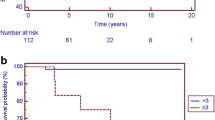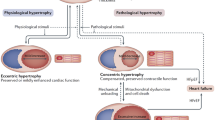Abstract
The risk stratification and early interventions are necessary in patients with hypertrophic cardiomyopathy (HCM), as life-threatening arrhythmia (LTA) is a leading cause of death. This study aimed to explore whether an interval between the peak of the T wave to the end terminal of the T wave (Tp-e), which represents ventricular repolarization dispersion, could predict the risk for LTA in children with HCM. We analyzed electrocardiography at the first and last visits in children (aged < 15 years) with HCM, and compared Tp-e interval and the ratio of Tp-e interval to QT interval (Tp-e/QT) between children with and without LTA. We studied 25 children with HCM. During the follow-up of 85 (38–146) months, there were 7 children with LTA. The 5-year sudden cardiac death (SCD) risk was 1.4 (1.1–2.5) %, which suggested that our cohort consisted of patients at a lower risk for SCD. Age was significantly older in children with LTA compared to those without it (12.5 vs.1.0 years, P = 0.037), although sex, the presence of family history and symptoms at diagnosis, the maximum left ventricular wall thickness Z-score did not differ between the groups. At the last electrocardiography before LTA, corrected Tp-e interval and Tp-e/QT ratio were significantly greater in patients with LTA compared to those in patients without LTA (corrected Tp-e: 103 vs. 78 ms, P = 0.020; Tp-e/QT: 0.28 vs. 0.22, P = 0.046). Corrected Tp-e and Tp-e/QT ratio cutoff values of 91 ms and 0.28 yielded as the predictors for LTA with sensitivity of 85% and 72%, specificity of 71% and 89%, respectively. Prolonged absolute and corrected Tp-e intervals and an increase in the Tp-e/QT ratio can be useful predictors for LTA in children with HCM. We offer temporal assessments of ventricular repolarization dispersion to stratify the risk for the development of LTA/SCD among children with HCM.
Similar content being viewed by others
Data Availability
All data will be offered if applicable.
Code Availability
Not applicable.
References
Arola A, Jokinen E, Ruuskanen O, Saraste M, Pesonen E, Kuusela AL, Tikanoja T, Paavilainen T, Simell O (1997) Epidemiology of idiopathic cardiomyopathies in children and adolescents. A nationwide study in Finland. Am J Epidemiol 146:385–393. https://doi.org/10.1093/oxfordjournals.aje.a009291
Lipshultz SE, Sleeper LA, Towbin JA, Lowe AM, Orav EJ, Cox GF, Lurie PR, McCoy KL, McDonald MA, Messere JE, Colan SD (2003) The incidence of pediatric cardiomyopathy in two regions of the United States. N Engl J Med 348:1647–1655. https://doi.org/10.1056/NEJMoa021715
Nugent AW, Daubeney PE, Chondros P, Carlin JB, Cheung M, Wilkinson LC, Davis AM, Kahler SG, Chow CW, Wilkinson JL, Weintraub RG, National Australian Childhood Cardiomyopathy Study (2003) The epidemiology of childhood cardiomyopathy in Australia. N Engl J Med 348:1639–1646. https://doi.org/10.1056/NEJMoa021737
Colan SD, Lipshultz SE, Lowe AM, Sleeper LA, Messere J, Cox GF, Lurie PR, Orav EJ, Towbin JA (2007) Epidemiology and cause-specific outcome of hypertrophic cardiomyopathy in children: findings from the pediatric cardiomyopathy registry. Circulation 115:773–781. https://doi.org/10.1161/CIRCULATIONAHA.106.621185
Ostman-Smith I, Wettrell G, Keeton B, Holmgren D, Ergander U, Gould S, Bowker C, Verdicchio M (2008) Age- and gender-specific mortality rates in childhood hypertrophic cardiomyopathy. Eur Heart J 29:1160–1167. https://doi.org/10.1093/eurheartj/ehn122
Norrish G, Cantarutti N, Pissaridou E, Ridout DA, Limongelli G, Elliott PM, Kaski JP (2017) Risk factors for sudden cardiac death in childhood hypertrophic cardiomyopathy: a systematic review and meta-analysis. Eur J Prev Cardiol 24:1220–1230. https://doi.org/10.1177/2047487317702519
Antzelevitch C, Di Diego JM (2019) Tpeak-Tend interval as a marker of arrhythmic risk. Heart Rhythm 16:954–955. https://doi.org/10.1016/j.hrthm.2019.01.017
Akboğa MK, Gülcihan Balcı K, Yılmaz S, Aydın S, Yayla Ç, Ertem AG, Ünal S, Balcı MM, Balbay Y, Aras D, Topaloğlu S (2017) Tp-e interval and Tp-e/QTc ratio as novel surrogate markers for prediction of ventricular arrhythmic events in hypertrophic cardiomyopathy. Anatol J Cardiol 18:48–53. https://doi.org/10.14744/AnatolJCardiol.2017.7581
Shimizu M, Ino H, Okeie K, Yamaguchi M, Nagata M, Hayashi K, Itoh H, Iwaki T, Oe K, Konno T, Mabuchi H (2002) T-peak to T-end interval may be a better predictor of high-risk patients with hypertrophic cardiomyopathy associated with a cardiac troponin I mutation than QT dispersion. Clin Cardiol 25:335–359. https://doi.org/10.1002/clc.4950250706
Ommen SR, Mital S, Burke MA, Day SM, Deswal A, Elliott P, Evanovich LL, Hung J, Joglar JA, Kantor P, Kimmelstiel C, Kittleson M, Link MS, Maron MS, Martinez MW, Miyake CY, Schaff HV, Semsarian C, Sorajja P (2020) 2020 AHA/ACC guideline for the diagnosis and treatment of patients with hypertrophic cardiomyopathy: executive summary: a report of the american college of cardiology/american heart association joint committee on clinical practice guidelines. Circulation 142:e533–e557. https://doi.org/10.1161/CIR.0000000000000938
Elliott PM, Anastasakis A, Borger MA, Borggrefe M, Cecchi F, Charron P, Hagege AA, Lafont A, Limongelli G, Mahrholdt H, McKenna WJ, Mogensen J, Nihoyannopoulos P, Nistri S, Pieper PG, Pieske B, Rapezzi C, Rutten FH, Tillmanns C, Watkins H (2014) 2014 ESC guidelines on diagnosis and management of hypertrophic cardiomyopathy: the task force for the diagnosis and management of hypertrophic cardiomyopathy of the european society of cardiology (ESC). Eur Heart J 35:2733–2779. https://doi.org/10.1093/eurheartj/ehu284
Norrish G, Ding T, Field E, Ziólkowska L, Olivotto I, Limongelli G, Anastasakis A, Weintraub R, Biagini E, Ragni L, Prendiville T, Duignan S, McLeod K, Ilina M, Fernández A, Bökenkamp R, Baban A, Kubuš P, Daubeney PEF, Sarquella-Brugada G, Cesar S, Marrone C, Bhole V, Medrano C, Uzun O, Brown E, Gran F, Castro FJ, Stuart G, Vignati G, Barriales-Villa R, Guereta LG, Adwani S, Linter K, Bharucha T, Garcia-Pavia P, Rasmussen TB, Calcagnino MM, Jones CB, De Wilde H, Toru-Kubo J, Felice T, Mogensen J, Mathur S, Reinhardt Z, O’Mahony C, Elliott PM, Omar RZ, Kaski JP (2019) Development of a novel risk prediction model for sudden cardiac death in childhood hypertrophic cardiomyopathy (HCM Risk-Kids). JAMA Cardiol 4:918–927. https://doi.org/10.1001/jamacardio.2019.2861
Rosenthal TM, Masvidal D, Samra FM, Bernard ML, Khatib S, Polin G, Rogers PA, Xue JQ, Morin DP (2018) Optimal method of measuring the T-peak to T-end interval for risk stratification in primary prevention. Europace 20:698–705. https://doi.org/10.1093/europace/euw430
Dinshaw L, Münch J, Dickow J, Lezius S, Willems S, Hoffmann BA, Patten M (2018) The T-peak-to-T-end interval: a novel ECG marker for ventricular arrhythmia and appropriate ICD therapy in patients with hypertrophic cardiomyopathy. Clin Res Cardiol 107:130–137. https://doi.org/10.1007/s00392-017-1164-4
Rautaharju PM, Surawicz B, Gettes LS, Bailey JJ, Childers R, Deal BJ, Gorgels A, Hancock EW, Josephson M, Kligfield P, Kors JA, Macfarlane P, Mason JW, Mirvis DM, Okin P, Pahlm O, van Herpen G, Wagner GS, Wellens H, American Heart Association Electrocardiography and Arrhythmias Committee, Council on Clinical Cardiology, American College of Cardiology Foundation, Heart Rhythm Society (2009) AHA/ACCF/HRS recommendations for the standardization and interpretation of the electrocardiogram: part IV: the ST segment, T and U waves, and the QT interval: a scientific statement from the American Heart Association Electrocardiography and Arrhythmias Committee, Council on Clinical Cardiology; the American College of Cardiology Foundation; and the Heart Rhythm Society: endorsed by the International Society for Computerized Electrocardiology. Circulation 119:e241-250. https://doi.org/10.1161/CIRCULATIONAHA.108.191096
Kanda Y (2013) Investigation of the freely available easy-to-use software “EZR” for medical statistics. Bone Marrow Transplant 48:452–458. https://doi.org/10.1038/bmt.2012.244
Yan GX, Antzelevitch C (1998) Cellular basis for the normal T wave and the electrocardiographic manifestations of the long-QT syndrome. Circulation 98:1928–1936. https://doi.org/10.1161/01.cir.98.18.1928
Takenaka K, Ai T, Shimizu W, Kobori A, Ninomiya T, Otani H, Kubota T, Takaki H, Kamakura S, Horie M (2003) Exercise stress test amplifies genotype-phenotype correlation in the LQT1 and LQT2 forms of the long-QT syndrome. Circulation 107:838–844. https://doi.org/10.1161/01.cir.0000048142.85076.a2
Topilski I, Rogowski O, Rosso R, Justo D, Copperman Y, Glikson M, Belhassen B, Hochenberg M, Viskin S (2007) The morphology of the QT interval predicts torsade de pointes during acquired bradyarrhythmias. J Am Coll Cardiol 49:320–328. https://doi.org/10.1016/j.jacc.2006.08.058
Castro Hevia J, Antzelevitch C, Tornés Bárzaga F, Dorantes Sánchez M, Dorticós Balea F, Zayas Molina R, Quiñones Pérez MA, Fayad RY (2006) Tpeak-Tend and Tpeak-Tend dispersion as risk factors for ventricular tachycardia/ventricular fibrillation in patients with the Brugada syndrome. J Am Coll Cardiol 47:1828–1834. https://doi.org/10.1016/j.jacc.2005.12.049
Watanabe N, Kobayashi Y, Tanno K, Miyoshi F, Asano T, Kawamura M, Mikami Y, Adachi T, Ryu S, Miyata A, Katagiri T (2004) Transmural dispersion of repolarization and ventricular tachyarrhythmias. J Electrocardiol 37:191–200. https://doi.org/10.1016/j.jelectrocard.2004.02.002
Xianpei W, Sha W, Chuanyu G, Juanjuan Y, Chong C, Yongen S, Yu F, Zhenhao L (2017) Tpeak-Tend dispersion as a predictor for malignant arrhythmia events in patients with vasospastic angina. Int J Cardiol 249:61–65. https://doi.org/10.1016/j.ijcard.2017.07.093
Savelieva I, Yap YG, Yi G, Guo XH, Hnatkova K, Camm AJ, Malik M (1999) Relation of ventricular repolarization to cardiac cycle length in normal subjects, hypertrophic cardiomyopathy, and patients with myocardial infarction. Clin Cardiol 22:649–654. https://doi.org/10.1002/clc.4960221011
Kanters JK, Haarmark C, Vedel-Larsen E, Andersen MP, Graff C, Struijk JJ, Thomsen PEB, Jensen HK, Toft E (2008) T(peak) T(end) interval in long QT syndrome. J Electrocardiol 41:603–608. https://doi.org/10.1016/j.jelectrocard.2008.07.024
Michalek P, Hatahet E, Svetlosak M, Margitfarvi P, Waczulikova I, Trnovec S, Böhm A, Benacka O, Hatala R (2020) No association between T-peak to T-end interval on the resting ECG and long-term incidence of ventricular arrhythmias triggering ICD interventions. Front Physiol 11:1115. https://doi.org/10.3389/fphys.2020.01115
Benatar A, Carbonez K (2010) Behavior of the electrocardiographic T peak to end interval in childhood. Ann Noninvasive Electrocardiol 15:11–16. https://doi.org/10.1111/j.1542-474X.2009.00334.x
Riza Demir A, Celik Ö, Sevinç S, Uygur B, Kahraman S, Yilmaz E, Cemek M, Onal Y, Erturk M (2019) The relationship between myocardial fibrosis detected by cardiac magnetic resonance and Tp-e interval, 5-year sudden cardiac death risk score in hypertrophic cardiomyopathy patients. Ann Noninvasive Electrocardiol 24:e12672. https://doi.org/10.1111/anec.12672
Hevia JC, Sanchez MD, Lopez FM, Chirino OC, Rodriguez RF, Bravo MP, Galguera JZ, Antzelevitch C (2019) Multiple serial ECGs aid with the diagnosis and prognosis of Brugada syndrome. Int J Cardiol 277:130–135. https://doi.org/10.1016/j.ijcard.2018.08.089
Sen Ö, Yilmaz S, Sen F, Balcı KG, Akboga MK, Yayla C, Özeke Ö (2016) T-peak to T-end interval predicts appropriate shocks in patients with heart failure undergoing implantable cardioverter defibrillator implantation for primary prophylaxis. Ann Noninvasive Electrocardiol 00:1–6. https://doi.org/10.1111/anec.12383
Benítez Ramos DB, Ortega MC, Hevia JC, Sánchez MD, Alemán Fernández AA, Chirino OC, Cardentey MC, López FM, Rodríguez RF (2017) Electrocardiographic markers of appropriate implantable cardioverter-defibrillator therapy in young people with congenital heart diseases. Pediatr Cardiol 38:1663–1671. https://doi.org/10.1007/s00246-017-1711-1719
Funding
This research received no grant from any funding agency in the public, commercial of not-for-profit sectors.
Author information
Authors and Affiliations
Contributions
NT analyzed data and described the first draft. JM designed and conducted this study and reviewed the manuscript. HE and MK collected echocardiographic data. HY collected electrocardiographic data. YS and MW critically reviewed this manuscript.
Corresponding author
Ethics declarations
Conflict of interest
The authors have no conflict of interest to declare.
Ethical Approval
This retrospectively single-institutional cohort study was approved by the Institutional Ethics Committee of Kyushu Hospital, Japan Community Healthcare Organization (Approval Number 807).
Consent to Participate
In all subjects, their parents or guardians provided informed consent for the procedures, but informed consent for this cohort study was waived owing to the retrospective nature.
Consent for Publication
All authors approved this publication.
Additional information
Publisher's Note
Springer Nature remains neutral with regard to jurisdictional claims in published maps and institutional affiliations.
Rights and permissions
About this article
Cite this article
Tashiro, N., Muneuchi, J., Ezaki, H. et al. Ventricular Repolarization Dispersion is a Potential Risk for the Development of Life-Threatening Arrhythmia in Children with Hypertrophic Cardiomyopathy. Pediatr Cardiol 43, 1455–1461 (2022). https://doi.org/10.1007/s00246-022-02867-3
Received:
Accepted:
Published:
Issue Date:
DOI: https://doi.org/10.1007/s00246-022-02867-3




